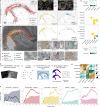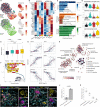Spatial Transcriptomics-correlated Electron Microscopy maps transcriptional and ultrastructural responses to brain injury
- PMID: 37433806
- PMCID: PMC10336148
- DOI: 10.1038/s41467-023-39447-9
Spatial Transcriptomics-correlated Electron Microscopy maps transcriptional and ultrastructural responses to brain injury
Abstract
Understanding the complexity of cellular function within a tissue necessitates the combination of multiple phenotypic readouts. Here, we developed a method that links spatially-resolved gene expression of single cells with their ultrastructural morphology by integrating multiplexed error-robust fluorescence in situ hybridization (MERFISH) and large area volume electron microscopy (EM) on adjacent tissue sections. Using this method, we characterized in situ ultrastructural and transcriptional responses of glial cells and infiltrating T-cells after demyelinating brain injury in male mice. We identified a population of lipid-loaded "foamy" microglia located in the center of remyelinating lesion, as well as rare interferon-responsive microglia, oligodendrocytes, and astrocytes that co-localized with T-cells. We validated our findings using immunocytochemistry and lipid staining-coupled single-cell RNA sequencing. Finally, by integrating these datasets, we detected correlations between full-transcriptome gene expression and ultrastructural features of microglia. Our results offer an integrative view of the spatial, ultrastructural, and transcriptional reorganization of single cells after demyelinating brain injury.
© 2023. The Author(s).
Conflict of interest statement
The authors declare no competing interests.
Figures






References
Publication types
MeSH terms
Substances
LinkOut - more resources
Full Text Sources
Molecular Biology Databases

